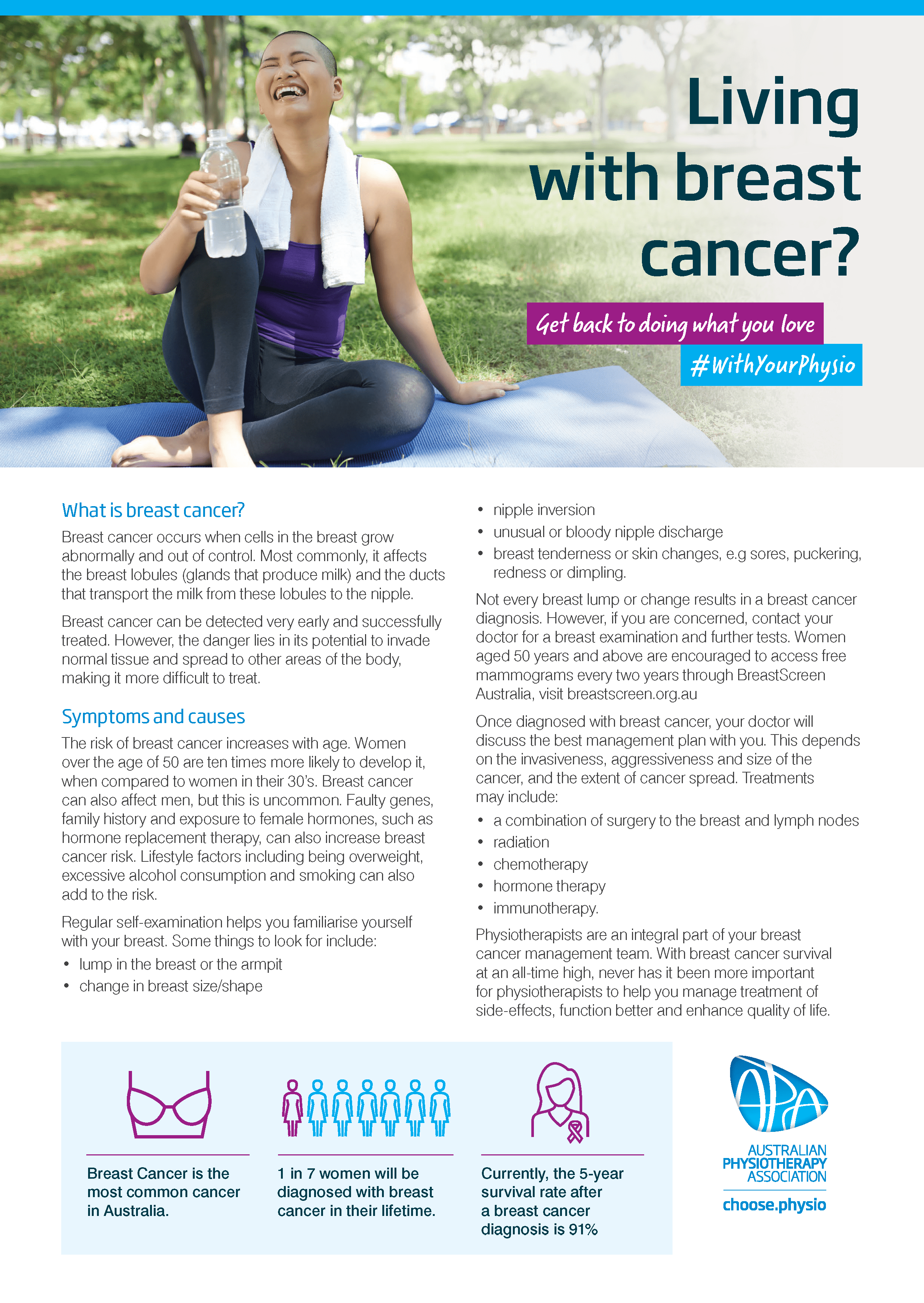Breast Cancer is the most common cancer in Australia, with 1 in 7 women being diagnosed in their lifetime.
Physiotherapy is a part of standard care in many Australian breast cancer treatment centres. Physiotherapists are ready to support and help you manage your health, regardless of the stage of your breast cancer journey.

--What is breast cancer?
Breast cancer occurs when cells in the breast grow abnormally and out of control. Most commonly, it affects the breast lobules (glands that produce milk) and the ducts that transport the milk from these lobules to the nipple.
Breast cancer can be detected very early and successfully treated. However, the danger lies in its potential to invade normal tissue and spread to other areas of the bod, making it more difficult to treat.
-- What are the symptoms and causes?
The risk of breast cancer increases with age. Women over the age of 50 are ten times more likely to develop it, when compared to women in their 30’s. Breast cancer can also affect men, but this is uncommon. Faulty genes, family history and exposure to female hormones, such as hormone replacement therapy, can also increase breast cancer risk. Lifestyle factors including being overweight, excessive alcohol consumption and smoking can also add to the risk.
Regular self-examination helps you familiarise yourself with your breast. Some things to look for include:
- lump in the breast or the armpit
- change in breast size/shape
- nipple inversion
- unusual or bloody nipple discharge
- breast tenderness or skin changes, e.g sores, puckering, redness or dimpling.
Not every breast lump or change results in a breast cancer diagnosis. However, if you are concerned, contact your doctor for a breast examination and further tests. Women aged 50 years and above are encouraged to access free mammograms every two years through BreastScreen Australia, visit breastscreen.org.au. Once diagnosed with breast cancer, your doctor will discuss the best management plan with you. This depends on the invasiveness, aggressiveness and size of the cancer, and the extent of cancer spread. Treatments may include:
- a combination of surgery to the breast and lymph nodes
- radiation
- chemotherapy
- hormone therapy
- immunotherapy.
Physiotherapists are an integral part of your breast cancer management team. With breast cancer survival at an all-time high, never has it been more important for physiotherapists to help you manage treatment of side-effects, function better and enhance quality of life.
-- What treatments are available?
Of course, everyone’s starting point and experience of breast cancer is different, and an impairment that affects one person may not affect another.
A physiotherapist can tailor an exercise program to address problems such as fatigue, pain, lymphoedema, flexibility, weight gain/loss, reduced strength and endurance. Manual therapy may be performed to provide relief for scars, tight tissues, cording and joint stiffness. Additional modalities such as laser, taping and dry needling may be used. Physiotherapists can also provide education and advice on bra/prothesis fit and breast support to facilitate return to activity and exercise.
Some breast cancer patients are at risk of arm lymphoedema or swelling. Early detection of lymphoedema is vital to the success in its management. An electrical bioimpedance machine may be used by your physiotherapist to assess changes in the fluid of your affected arm. Physiotherapy treatment for lymphoedema includes compression bandaging and garments, manual lymphatic drainage, skin care and exercise.
Physiotherapists are ready to support and help you manage your health, regardless of the stage of your breast cancer journey. Physiotherapists understand the complexities of the anatomy and function after breast cancer, so are best placed to help you achieve your desired goals considering any risks or impairments you may have.
--What side effects could I experience from these treatments?
Common impairments encountered by breast cancer patients include:
- shoulder stiffness
- lymphoedema (swelling in the affected arm or breast due to removal of lymph nodes)
- reduced fitness
- scar adhesions and tissue tightness
- pain
- weakness
- fatigue.
-- How can physio help?
Physiotherapy is a part of standard care in many Australian breast cancer treatment centres. In other centres, referrals to physiotherapy can be made by health professionals. Ask your doctor or nurse if you haven’t yet seen a physiotherapist.
Physiotherapists have a unique and diverse skill-set to assess, prevent/minimise and treat various impairments you may have, or are at risk of developing, during your breast cancer journey. You may come across physiotherapists at diagnosis, through treatment and beyond.
After a breast cancer diagnosis and before the start of the treatment, a physiotherapist may assess your health function, perform baseline measurements and educate about the risk of potential side-effects, such as arm swelling. After surgery, you may see a physiotherapist on the ward for breathing exercises and stretches to assist in recovery of arm function and mobility. A physiotherapist may also provide in-home visits after hospital discharge, to further progress exercises and make referrals if necessary for shoulder or arm rehabilitation.
--Factsheet on breast cancer
Click the image to download the factsheet.

